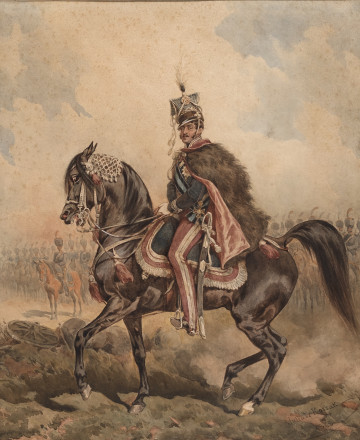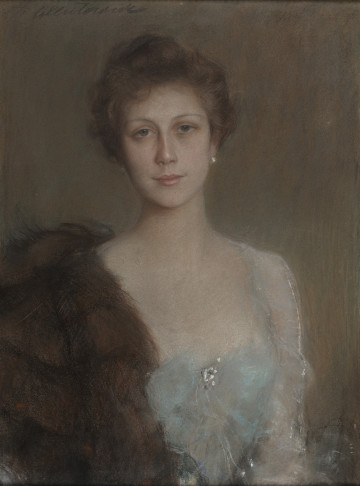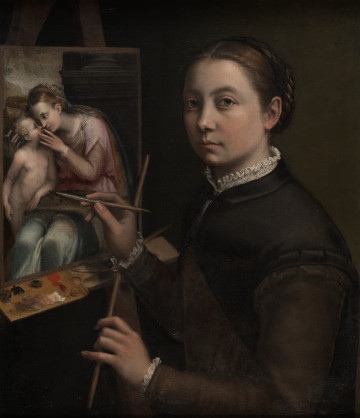
Prince Józef Poniatowski on horseback
19th (?) century
Castle Museum in Łańcut
Part of the collection: Malarstwo i rysunek
Mounted Tadeusz Kościuszko The painting belongs to the collection of the Potoccy family, the former owners of the castle; it is a mounted portrait of Tadeusz Kościuszko, painted by Juliusz Kossak. The painting is an aquarelle, in a decorative passe partout, behind a glass, in a broad gilded and profiled frame. The horse and the rider are shown in motion, there are scythemen in the background. In the lower right hand corner of the painting, there is a signature and date „Juliusz Kossak 1879”. Andrzej Tadeusz Bonawentura Kościuszko (b. February 1746 in Mereczowszczyzna, present-day Belarus, d. in October 1817 in Solothurn, Switzerland) was a military engineer, commander-in-chief of the national armed forces during the Kościuszko uprising; he participated in the United States war of independence. He originated from a Belarussian noble family which, in time, became polonised. Choosing a military career in 1765, he joined the Corps of Cadets at the School of Chivalry in Warsaw, which in turn was created at the initiative of Stanisław August Poniatowski; he graduated ranked captain. In 1769 he left for Paris, supported by Adam Kazimierz Czartoryski, provided with a royal scholarship. He remained in France for five years, and this stay influenced his political convictions. In the Summer of 1775 he returned to Poland, but not finding employment in the army, he left for Dresden, then again to Paris. In June 1776 he travelled to South America, where, using his engineering skills, he contributed to the United States victory at Saratoga. With consent of the commander-in-chief of the United States Army, George Washington, he was also contracted to build the fortress of West Point (presently the famed military training facility). He returned to Poland in July 1784, and, after the outbreak of the Polish-Russian War of 1792, he was named commander of one of the three divisions of the royal forces, the leader of which was prince Pepi (as Józef Poniatowski was called). Following the victorious battle of Zieleńce, he was decorated by king Stanisław August with the Order of Virtuti Militari. After the king joined the Targowica Confederation, Kościuszko left again for Paris via Leipzig. In Paris, he developed the plans for a national uprising. Returning to Poland, on March 24th, 1794, in the Market Square of Kraków he made a vow to the nation and named himself leader of the uprising. Using his experiences from his tour in America as the basis, he created divisions of scythemen that made history by their victory in the battle of Racławice. In the battle of Maciejowice, Kościuszko was wounded and came under Russian imprisonment, only released in 1796 following his oath of submission. He was also ordered to leave the country without the right to return. He remained in exile until his death, passing away in Switzerland. Juliusz Kossak (b. in October 1824 in Nowy Wiśnicz, d. in February 1899 in Kraków) is a known Polish painter, illustrator and drawing artist. His body of work mainly includes historic and battle depictions, and a favourite topic of his are horses. From his childhood onwards, he lived in Lviv, where he graduated from the university having completed studies in law. He initially learned painting under Jan Maszkowski, but Piotr Michałowski became his master. In 1844, thanks to his acquaintance with the Dzieduszyccy family, he was introduced into circles of landowners, and remaining in aristocratic courts (Potoccy), he painted hunting scenes and portraits, including those of horses. Having married Zofia Gałczyńska, he left for Paris with his wife, where he studied museum collections. After a short stay in Munich, he returned to Poland and took up residence in Kraków, in a manor called Wygoda (Pol. Comfort), later the Kossakówka. He is considered to be the creator of Polish battle painting, his work was meant to raise spirits (it was the time of the partitions of Poland), and his skills in his preferred watercolour technique became masterful.
Author / creator
Dimensions
height: 78 cm, width: 63 cm
Object type
Painting and drawing
Technique
aquarel
Material
paper
Origin / acquisition method
decyzja administracyjna
Creation time / dating
Creation / finding place
Owner
Castle Museum in Łańcut
Identification number
Location / status

19th (?) century
Castle Museum in Łańcut

19th (?) century
Castle Museum in Łańcut

16th / 17th century
Castle Museum in Łańcut
DISCOVER this TOPIC
Castle Museum in Łańcut
DISCOVER this PATH
Educational path